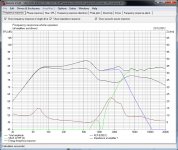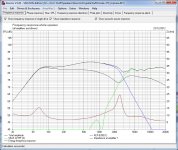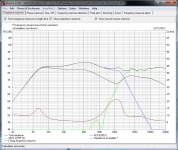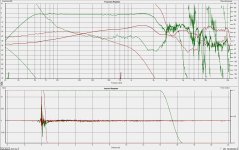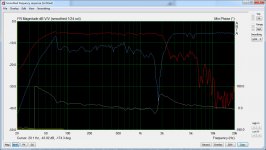Just read your last thread and I now understand where this crossover came from, I think you are heading in the right direction by measureing things and probably a complete redesign of the 'guessed' crossover is going to be best. The bextrene cone b200 is not so great and could be vastly outperformed by some quite modestly priced drivers, eg seas or SB, as others have said, the crossover point is way to high at 3k, so you will have major directional issues and a poor integration of tweeter and bass (for an 8 inch cone 2k is probably a sensible upper limit) this means you will need steep slopes to keep tweeter distortion down and the bextrene breakup out of things, probably LR4, but with mesurment and computer optim this is quite achievable. In the end you could well exceed what was achieved by KEF in the early seventies using a slide rule and echoic anechoic chamber, things have moved on.
Laurence
Laurence
I've had a look at the crossover and how removing the notch filer or additional resistance appears to affect things in the boxplot simulation. I'll give removing the filter a go first and have a rough measure with the mic. (boxplot sim shows the woofer output above 1K rise and the crossover point fall slightly)
Somewhere between 10 and 20 ohms seems to offer sufficient smoothing. Do you think this is about right and if so what sort of watt rating would i need?
Pictures show the current config with the notch, followed by removing the notch completely and the last image shows the effect of an extra 10R in series.
Somewhere between 10 and 20 ohms seems to offer sufficient smoothing. Do you think this is about right and if so what sort of watt rating would i need?
Pictures show the current config with the notch, followed by removing the notch completely and the last image shows the effect of an extra 10R in series.
Attachments
Here are the measurements with the notch filter removed. Certainly seems to remove the 5dB dip at 1K. Not certain if it has had any other effects at the crossover point, looks pretty similar to me.
As for measuring impedance/phase response, you may have to give me a few pointers.
As for measuring impedance/phase response, you may have to give me a few pointers.
Attachments
Are those measurements outside or nearfield or something? They look surprisingly free of reflections into the low frequencies. Anyway, the easiest way to do a 2-way (IMO) is to measure both drivers from the same location. That means you have to make your simulation settings put both drivers on top of each other (don't simulate off-axis response, in other words).
When you're doing it that way with ARTA, all you have to do is position your mic around 1m away with the vertical position at the midpoint between driver centers. Take measurements of one driver at a time without crossover, setting the gate as long as you can without ripple coming in from reflections. MLS mode with 4-5 averages works fine and is fast. Then, when you pull up the FR window (the one you just posted above), have your view settings to show phase and response, check "unwrap phase" and "minimum phase" under view, and then export as plain text from the file menu. Oh, and most sim software won't like negative dB values, so you want normal decibels on the spl scale, rather than referenced below 0dB. Repeat for the other driver without changing volume or any other settings, and then also do both drivers in parallel if you have two amp channels to do this with safe impedance (this is used to check simulation settings before you get to the crossover design).
I didn't mention tweeter protection because I usually skip it, just keeping levels low, amp muted until measurement. If you don't want to be so risky, you can use a large protection cap and/or use a measurement mode with a LF cutoff. This will throw your phase off a bit, but probably not enough to matter at your highish crossover frequency here.
Then, you need an impedance file for each driver, for which you can set up a rig to measure in LIMP or something else, or trace the mfg. curve.
The details of importing and setting up your files in boxplot, I can't do off the top of my head because I have only used that program a couple of times, but I can try it later.
When you're doing it that way with ARTA, all you have to do is position your mic around 1m away with the vertical position at the midpoint between driver centers. Take measurements of one driver at a time without crossover, setting the gate as long as you can without ripple coming in from reflections. MLS mode with 4-5 averages works fine and is fast. Then, when you pull up the FR window (the one you just posted above), have your view settings to show phase and response, check "unwrap phase" and "minimum phase" under view, and then export as plain text from the file menu. Oh, and most sim software won't like negative dB values, so you want normal decibels on the spl scale, rather than referenced below 0dB. Repeat for the other driver without changing volume or any other settings, and then also do both drivers in parallel if you have two amp channels to do this with safe impedance (this is used to check simulation settings before you get to the crossover design).
I didn't mention tweeter protection because I usually skip it, just keeping levels low, amp muted until measurement. If you don't want to be so risky, you can use a large protection cap and/or use a measurement mode with a LF cutoff. This will throw your phase off a bit, but probably not enough to matter at your highish crossover frequency here.
Then, you need an impedance file for each driver, for which you can set up a rig to measure in LIMP or something else, or trace the mfg. curve.
The details of importing and setting up your files in boxplot, I can't do off the top of my head because I have only used that program a couple of times, but I can try it later.
Last edited:
- Status
- This old topic is closed. If you want to reopen this topic, contact a moderator using the "Report Post" button.
